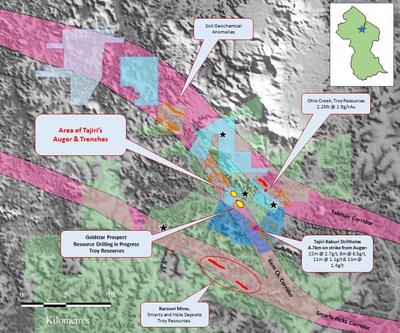The area of investigation is resolving into three zones of mineralization:
- A high-grade zone:
The Magic Crack Zone (or the "MCZ") which is associated with the contact of variably graphitic sediments and mafic volcanics where trenching to date has returned 2m @ 61.8 g/t Au, 1m @ 16.2g/t Au, 2m @ 9.2 Au, 2m @ 9.6g/t Au, 1m @ 4.2g/t Au and 6m @ 3.5g/t including 2m @ 8.0g/t Au over a strike length of 500m - A low-grade zone:
The Pretty Ordinary Zone (or the "POZ") which is associated with a series of small felsic and microdioritic/doleritic intrusives that presents as zones 2-20m wide variably grading between 0.1 and 0.8g/t Au with rare values >1.0g/t, along with two better intersections near the MCZ of 12m @ 2.8g/t and 9m @ 0.9g/t including 5m @ 1.5g/t. This mineralization is associated with flat to shallow dipping quartz vein sets or in the better mineralized intervals with stockwork veining in or at the margins of the intrusive. Thus, the POZ may show considerable vertical grade variation related to density of horizontal vein sets and will require drill testing. - The newly discovered on strike extensions of Troy Resources Goldstar Prospect:
The Goldstar Extended Zone (or the "GETZ") which was intersected in Trench 13 and returned 12m@ 0.6g/t including 3m @ 1.0g/t and 13m@ 0.5g/t including 6m @ 1.0g/t Au. These intersections are located 880m to the northwest of and directly on strike from Goldstar where Troy has now commenced trial mining. The two zones are separated by approximately 35m across strike. Investigation of the strike continuity between Goldstar and the GEEZ will require drilling as the entirety of the strike of the GETZ between Trench 13 and Goldstar is covered by alluvium most of which has been heavily worked by artisanal miners.
The high-grade intersections of 2m @ 9.6g/t and 2m @ 9.0g/t extend mineralization as reported
Of the two trenches which effectively tested the on-strike extensions of the MCZ, Trench 1J intersected 6m @ 3.5g/t including 2m @ 8.0g/t and 1m @ 4.2g/t Au. 500m to the northwest of the Trench 1A intersections of 2m @ 61.8g/t and 1m 16.2g/t Au, and Trench 1G which tested the MCZ ~200m to the NW of the Trench 1 A intersections visually intersected mineralized material which produced considerable fine gold from panning but no significant fire assay values. The company is currently resampling Trench 1G and re-assaying existing visually mineralized samples and results will be released when available.
As reported previously the MCZ contact zone continues to the SE and although only low grade mineralization has been intersected to date it is nonetheless persistent in the 0.5-2.0g/t range over a width of 2-4 metres.
Figure 1 shows the location of the Epieus project and Figure 2 shows all above discussed mineralized zones and trenched intersections.
Executive Chairman
Qualified Person
The Qualified Person under National Instrument 43-101 - Standards of Disclosure for Mineral Projects for this news release is
On Behalf of the Board,
President & CEO
About Tajiri
This news release may contain forward-looking statements based on assumptions and judgments of management regarding future events or results. Such statements are subject to a variety of risks and uncertainties which could cause actual events or results to differ materially from those reflected in the forward-looking statements. The Company disclaims any intention or obligation to revise or update such statements.
Neither the
For results of GCRC083 see: announcement by Troy Resources Ltd: Further High-Grade Drilling Results at
Map of Troy's Goldstar Prospect is sourced from their announcement: Exploration Update,


SOURCE
© Canada Newswire, source

